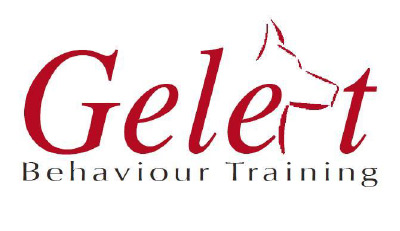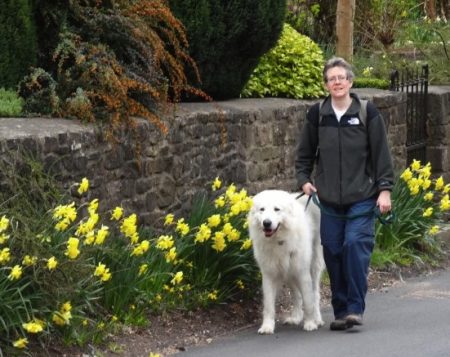I’d like to welcome newly appointed Gelert correspondents Nicola and Ted, who attended our recent workshop with Janet Finlay. They are “staff” to a gorgeous spaniel, and are keenly learning to tend his needs, and have kindly agreed to write up events they attend for us ! Thank you to you both for this great write up.
If you would like to learn more from Janet, then please visit her website https://www.canineconfidenceacademy.com
This fascinating seminar was for the owners of “reactive” dogs to help them better manage their daily experiences with their more challenging canine companions who were given leave of absence from this study day!
The whole focus was how to manage our expectations and emotions rather than spend time finding unhelpful labels for our dogs and viewing them as the foremost problem when the way we react can help or hinder situations we encounter with our dog(s) which involves other people, other dogs or indeed other animals who cross our path.
Our language and our posture are very important in creating the right atmosphere for a trouble-free walk with enjoyment and confidence in the ascendancy rather than fearful anticipation being our first line of defence. If you look to the negatives in any situation then this will escalate rather than ameliorate any rising tension when calm and competence will ensure a better outcome.
This can be summed up with the acronym – ACE
Agency, Confidence, Competence
Agency requires changing our MINDSET, LANGUAGE, BELIEFS & RESPONSES
The critical factor is MINDSET – if we always hold to a THREAT MINDSET then this will increase our adrenaline and cortisol levels resulting in chronic stress that will not only transmit itself to our highly strung dog but keep us in an always ready state of heightened tension which may or may not be appropriate to what we are facing.
We need to challenge that mindset so that we practically rather than emotionally deal with the specific problem which requires practice and competence to manage and focuses on what we CAN rather than what we CAN’T do – success rather than failure. Practice through play without stress will better prepare us for real-life situations.
We tend to live by our beliefs, for example , “I’m not good in a crisis” which can lead to a self-fulfilling prophecy but you can turn that negative emotion into something more positive and meaningful which in turn will assist your dog to learn a different way of reacting.
Dogs pick up on triggers so anything that increases arousal for your dog should be avoided – if you feel stressed before a walk it would better to defer that walk to another time.
We all have choices in how we respond to given situations – we can choose to dismiss the negative responses from others and have the belief that what we are doing is the best we can do at this time but this is work in progress so don’t beat yourself up!
The more practice and experience in being prepared, doing recall and scanning your environment for possible problems is key and thereby giving yourself the precious time to manage a potential hazard – ie moving and parked cars, residential houses and garden gates, horses, livestock, bikes, dog walkers, busy roads etc.
Lead walking can be improved with a 2-point contact harness which feels feels more balanced for the dog and stroking the lead can emit calmness to the dog – the ideal is to set a boundary in which a dog can freely move but is contained rather than restrained. Any equipment used on a dog needs to be first and foremost a means of communication rather than a torture instrument, to guide rather than to coerce.
The owner needs to keep a clear focus on his/her dog so that bonding naturally ensues and it is preferable to go on shorter, quality walks where a dog is fully engaged with you rather than a longer walk where you and you are dog are on different planets!
Managing meltdowns is another vital part of keeping your dog stress-free and ensuring he/she is contained and near to you. Depending on the situation facing you to quickly decide whether it’s better to stay put or avoid and if you have been scanning your environment you have time to assess and execute either decision. The problem arises where a situation comes upon you without warning due to sudden blind spots – don’t risk it – change your route and back-track if necessary but don’t let this only happen in this particular place – zig-zag your directions in other environments so the dog doesn’t associate this place with avoidance or trouble.
Should an incident be unavoidable there are various strategies that the owner can employ such as pattern games which involves distracting the dog using treats thrown at random which has the effect of moving the dogs away from each other which in turn lowers heart rate and respiration levels or if the situation allows the owner to use the ZEBRA TOUCH crossing and raking back along the side length of the dogs coat as a calming measure or alternatively to stroke their ears by gently sliding along the contour of the ears which controls all the pressure and shock points simultaneously.
As for the human response to a stressful incident this should be countered with calm but controlled breathing – sometimes known as box breathing – try and visualise a square box and use the 2 vertical sides to represent your in and out breaths and the 2 horizontal sides as the pause between each in and out breath. Another useful T touch is to put your hand on your chest and revolve it round in conjunction with your breathing. Don’t drive until you feel less stressed should you have driven to your destination. And remember sometimes bad things do happen but it’s what we learn from it that matters most.
There is an excellent book called “The Education of Will” by Patricia McDonnell which is a must-read – in it she conducts an experiment as to what to do if you come across a loose dog intent on harm – she chucked a whole load of treats at the out of control dog which stopped it in its tracks, giving just about enough thinking time – but what she did say that in those extreme circumstances you have to do anything to protect your dog as you may have no other choice.
Janet thinks muzzles are a fantastic way of taking the stress away from owners of reactive dogs as it gives peace of mind while giving healthy exercise to such dogs – if a dog has ever bitten a person then it is irresponsible to not muzzle that dog – it is just not worth taking that risk in public areas.
Another author, Tracey McKennell used an ingenious method of taking a pop-up umbrella as a physical barrier between troublesome dogs and the beauty of this is that no one can make the accusation of carrying an offensive weapon in a public place because people guard against inclement weather….
Be friendly but FIRM if you do not wish a stranger to touch your dog and put your hand out if necessary – without sending out alarm signals which ratchets up the stress. The message in all this is that prevention is better than regret after the event….a very important finding is that dogs can pick up on our stress and anxiety and this has a direct influence on how our dogs will respond – the moment you let go of intention and take the pressure off the dog the more likely it will be to do what you are asking of it so being relaxed around your dog always pays off.
Other play activities that can help relax your dog include the following:
a) scentwork ie hiding pieces of cheese in a given area and seeing how long it takes your dog to seek these out – fun but stimulating
b) how to play tug with your dog – this is brilliantly conveyed in a book of the same title by Craig Ogilvy – interactively engaging with your dog
c) Park all – where the environment is used as a problem-solving space for dogs to explore going on, off, under, over and along objects….
The next area of discussion centred around EXPERIENCE – all of us have some degree of inner strength gained through experience but it’s unfortunately human nature to focus on the negatives rather than the positives of any given experience – one way to challenge this misconception is to write down and list your own strengths and those of your dog and when you need reassurance remind yourself of these.
Scientific research has demonstrated that ones posture has a very great bearing on one’s confidence levels and in a controlled group experiment it was found that power posing for 2 minutes led to a 20% increase in testosterone and a 25% decrease in cortisol levels but for those in a closed down posture there was a decrease of testosterone by 10% and cortisol levels went up by 15%.
As such one can change how one is perceived with open, expansive gestures or hands on hips can give a more confident bearing with the more closed postures indicating a more fearful and hesitant attitude. Another helpful book on body language is a book entitled Presence by Amy Cuddion. Our physical demeanour influences our emotional state and there is scientific evidence that it prompts actual changes in our brain chemistry.
A very simple way to encourage good posture while walking the dog is to use a 3” shrug-wrap which you wrap round your shoulders as if you have an imaginary rucksack on your back and this just makes you more aware of keeping a more open posture but as Janet sensibly advised perhaps wear it discreetly under clothing on display!
Finally, Janet’s parting message was that we all need to think of power-ups every day – ie anything that makes you feel energised and good about yourself and what happens to you and your dog – the aim is to build on lots of small positive experiences – it could be as simple as watching your dog play or encouraging someone else and giving them a power up etc.
It’s important to give yourself rewards and have allies around you – real-life people who are helping you on this journey of discovery with your dog so that we actively seek new challenges to both develop our own potential and that of our faithful canine companions. She urged us to keep a journal so we can record progress and reflect on our successes and challenges as well as refer to and interact with on-line buddies on the website, Reactive Dogs UK. Also it could prove useful to be aware of the the laws around dogs by referring to the authoritative publication – Dog Law by Trevor Cooper.
Janet’s parting shot was to encourage each one of us attending to set ourself a written down goal of something we wish to change for the better in the guardianship of our pet dogs.
Bravo, Janet and thank you for giving your audience such an informative and entertaining day!

